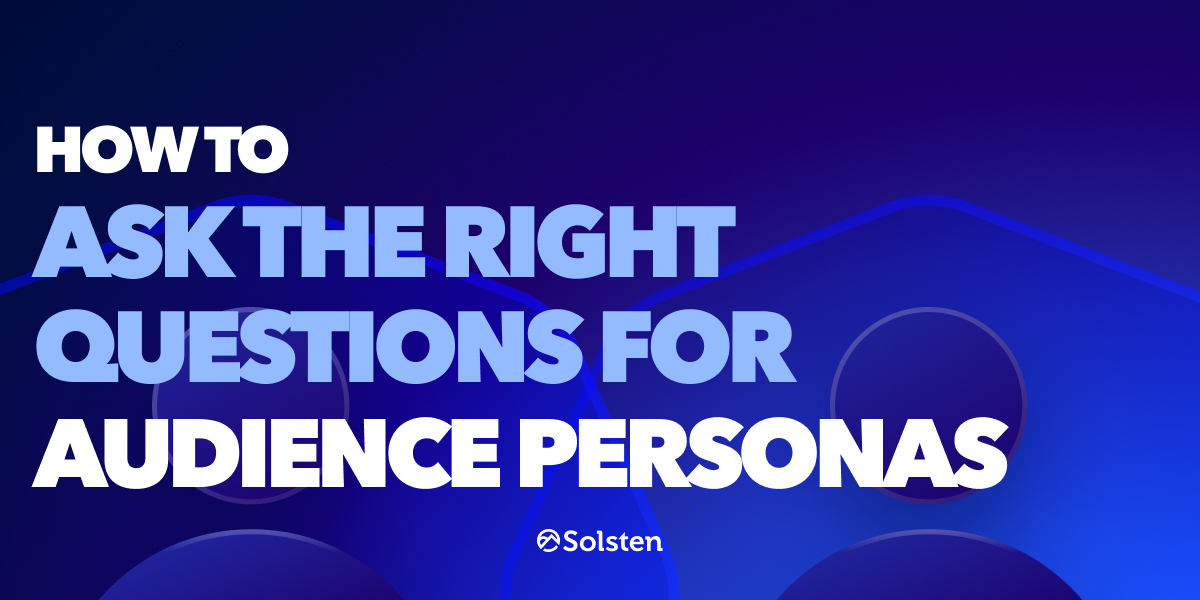Here’s a scenario that might sound familiar. Your VP of Marketing proudly presents their latest customer personas deck. Twenty-three slides of “Gym Rat Gary” complete with a stock photo of a guy doing bicep curls and bullet points like “values efficiency” and “shops online frequently.”
The obvious question: “If Gary walked into this room right now, what would he actually say about your product or service?”
Usually, nobody knows the answer.
Even as technology has progressed, most audience personas remain stuck in the past. They’re static. They’re heavily focused on demographics and behavior. And worst of all, they take a lot of time to make and aren’t very helpful.
This highlights a significant problem: most companies are asking the wrong questions for audience personas. They’re building elaborate fictional representations instead of understanding real people. It’s costing them dearly in wasted time and missed opportunities.
In this article, we’ll show you:
- Why traditional persona questions produce useless profiles (and the psychological blind spots most teams don’t know they have)
- 5 specific questions that reveal actual customer motivations instead of surface-level preferences
- A simple framework for creating your own psychology-revealing questions that predict behavior in new situations
- How to skip the research phase entirely using AI-powered persona conversations that give you instant insights with Elaris
The Great Audience Persona Charade
Most customer personas are flawed by design. Companies spend months making “Health-Conscious Helen” profiles using intricate buyer persona templates. Then, they can’t answer basic questions like “Why would Helen trust our brand over a competitor?”
We recently surveyed 351 marketing leaders across industries and company stage. It revealed some honestly depressing results:
- Only 40% think their personas reflect their actual target customers
- 77% admit they don’t understand the “why” behind customer behavior
- 74% worry their insights aren’t strategic enough to help sales teams and marketing campaigns
Yet 63% are still updating these same broken personas every year. They’re following the same old questions for audience personas, focusing on surface-level demographics like age, gender, and location. Instead, they should figure out what actually drives purchasing decisions.
The Questions for Audience Personas That Don’t Actually Matter
Walk into any persona workshop and you’ll hear the same questions for audience personas:
“What’s their age, gender, location?”
“What platforms do they use?”
“How often do they buy?”
“What’s their typical decision making process?”
These feel important because they’re measurable. They’re a decent starting point, but they’re also completely useless for predicting behavior. They don’t help teams create content that resonates with their target audience.
Consider a fitness app company that built gorgeous customer personas based on workout frequency, age groups, and platform preferences. They built their marketing strategies around these demographics.
Then the pandemic hit.
Suddenly “Gym Rat Gary” was doing yoga at home and “Weekend Warrior Wendy” was running marathons. All the behavioral data became irrelevant overnight.
But here’s what didn’t change: Gary’s underlying need to feel accomplished and in control. Wendy’s drive to challenge herself and prove her capabilities. Those psychological drivers stayed constant even when everything else shifted.
They should have been the foundation of questions for audience personas from the start.
The Questions for Audience Personas That Actually Matter
Most companies avoid the hard questions for audience personas. This is because they require actual audience research, not just data mining from existing customers.
The questions for audience personas that matter dig into psychology, not demographics:
Instead of “What do they buy?” ask “What are they trying to become?”
Here’s an example:
A popular skincare brand obsessed over purchase frequency data for its customer personas. Their sales teams were struggling because they were positioning products instead of transformations.
It turned out their ideal customers weren’t buying products. They were actually buying confidence. Once the company understood that core motivation, everything from content marketing to customer service transformed.
Instead of “Where do they shop?” ask “How do they make decisions when they’re uncertain?”
This completely changes marketing strategies. Someone who researches extensively needs different content marketing than someone who relies on social proof or expert recommendations. Questions for audience personas should reveal these decision-making patterns.
Instead of “What features do they use?” ask “What role does the product or service play in their identity?”
Are you a tool, a status symbol, or part of their self-expression? The answer determines everything from product development to customer experience design.
5 Questions That Reveal What Matters
Most persona questions are like asking someone what they had for breakfast and expecting to understand their relationship with food. You get surface-level answers that tell you nothing about the deeper motivations driving their choices.
After seeing many persona projects fail due to asking the wrong questions, here are five questions that really help create a persona. These questions cut through the noise and show the psychological drivers.
1. “Walk me through the last time you had to make a difficult decision in this area. What made it difficult?”
This question reveals decision-making anxieties and what they need to feel confident. This will help you learn if fear of making mistakes, need for social validation, desire for control, or something else entirely drives the subject.
Bad answer: “I just compared features and prices.”
Good answer: “I spent weeks researching because I was terrified of choosing something that would make me look unprofessional to my team.”
The second answer shows that this person seeks professional reputation and needs extensive validation before committing.
2. “What would have to be true for you to feel completely successful with [your product/service category]?”
Most people ask a version of “What do you want our of [product/service]?” This question digs deeper into identity and self-concept. It reveals what success means to them personally, not just functionally.
Bad answer: “It would work well.”
Good answer: “I’d feel like I finally had control over this part of my life and could focus on things that actually matter to me.”
Now you know this person values autonomy and views your product category as a means to focus on higher priorities.
3. “Tell me about a brand you’re genuinely loyal to. What is it about them that keeps you coming back?”
This reveals their loyalty drivers across categories. People are remarkably consistent in what builds their trust and keeps their attention. This is true whether they’re talking about coffee shops or software companies.
Bad answer: “They have good products.”
Good answer: “They never try to upsell me or make me feel stupid. I feel like they respect that I know what I need.”
This person values others treating them as competent and dislikes feeling that others manipulate them. These insights will help inform how to communicate with them.
4. “What’s something you believed about this category that turned out to be completely wrong?”
This uncovers their learning style, how they process new information, and what misconceptions they might still hold. It also reveals whether they’re open to changing their minds or defensive about past mistakes.
Bad answer: “I don’t know, nothing really.”
Good answer: “I used to think expensive meant better quality, but after getting burned a few times, now I spend way more time reading reviews and looking for proof.”
This shows they’ve evolved from price-based to evidence-based decision-making and now need social proof and validation.
5. “If you could give advice to someone just starting out in your situation, what would you tell them?”
This reveals their values, what they wish they’d known, and how they see their role in relation to others. People who mentor others have different psychological drivers than people who prefer to figure things out alone.
Bad answer: “Just be careful and do your research.”
Good answer: “Don’t be afraid to ask for help. I wasted so much time trying to figure everything out myself when there were people who could have saved me months of frustration.”
This person values community, learning from others, and likely responds well to expert guidance and social proof.
How to Create Better Questions for Your Audience Personas
Give someone a list of questions, and they’ll build one persona. Teach them how to create questions, and they’ll build personas that actually predict behavior.
The secret isn’t having the perfect questions, but understanding what makes a question psychologically revealing versus surface-level.
The “Why Behind the Why” Technique
Most questions stop at the first “why.” The magic happens when you dig deeper.
Surface question: “What features matter most to you?”
Better question: “What features matter most to you, and what does having those features say about you as a person?”
The second version reveals identity and self-concept, not just preferences.
The Context Shift Method
Ask the same psychological question across different contexts to reveal consistent patterns.
“How do you typically make decisions when you’re uncertain?” (general)
“How did you choose your current job?” (career context)
“How do you decide which restaurants to try?” (low-stakes context)
“How did you choose where to live?” (high-stakes context)
People who need extensive research across all contexts are driven by need for control. People who rely on recommendations across contexts value social proof and community input.
The Identity Bridge Approach
Connect functional decisions to personal identity by asking how choices reflect their values or role.
Instead of: “What’s your budget?”
Ask: “What does spending money on this category mean to you?”
Some people see spending as investment in their future selves. Others see it as necessary evil. Others view it as self-care or family responsibility. Same budget, completely different psychological drivers.
The Failure Mode Question
Ask what would make them feel like they failed or made a bad choice. This reveals their core fears and values more clearly than asking what they want.
“What would make you regret this decision six months from now?”
“What would make you feel like you wasted your money?”
“What would make you feel stupid for choosing this?”
Testing Your Questions
Good persona questions should reveal information that helps you predict behavior in new situations. Test your questions by asking:
- Would two people with the same demographics but different psychology answer this differently?
- Does the answer help me understand how they’d react to something they’ve never seen before?
- Can I use this answer to predict their response to different messaging approaches?
If the answer is no, you’re probably asking demographic or behavioral questions disguised as psychological ones.
The Shortcut (Because Who Has Time to Become a Psychology Expert?)
Creating good questions for audience personas requires understanding psychology, human motivation, and decision-making patterns. Most marketing teams don’t have time to become experts in behavioral psychology on top of everything else they need to do.
If you want comprehensive question lists organized by industry and use case, grab our 101 Questions to Ask Your Customers guide. It will teach you how to:
- Ask questions your competitors aren’t asking
- Turn customer conversations into competitive advantages
- Build a system for continuous customer insight
But if you want to skip the manual research entirely and just have conversations with psychologically accurate representations of your audience, that’s exactly what Elaris does.
Instead of spending weeks creating the perfect questions and then months gathering responses, you can literally ask your target audience anything you want to know. Elaris gives you answers based on real psychological data.
“What would make you trust our brand over competitors?”
“How would you explain our product to a friend?”
“What concerns would prevent you from trying this?”
“Which of these messaging approaches feels more authentic?”
No surveys, no interviews, no guessing whether your sample size is representative. Just direct conversations with AI-powered personas built on psychological insights from millions of real people.
Whether you go the DIY route with better questions or let Elaris handle the psychology for you, the key is moving beyond surface-level demographics to understand what actually drives human behavior.
Because at the end of the day, your customers aren’t data points. They’re complex humans with motivations, fears, and aspirations that go way deeper than their age, income, and shopping frequency.
Understanding that psychology is what separates companies that build products people tolerate from companies that build products people love.
Want to learn how to create personas that actually work with Elaris? Check out our step-by-step tutorial and start turning insights into action today.



